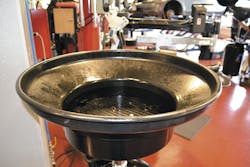Winter car care is more about temperature than weather conditions. The cold directly affects many parts of the vehicle, including the battery, motor oil, tires, even windshield wiper blades.
That is why your multi-point inspection needs to be adapted before December rolls around. In that way, your customers will be taken care of throughout the winter months, and your sales promotions will be on target.
The following eight “inspectibles” focus on the winter season. They were collected from a variety of sources that directly deal with winter driving, from tire dealers to Allstate Insurance Co.
One of the tire dealers, Colony Tire Corp., is based in Edenton, N.C., where the average snowfall is three inches December through February. However, from the beginning of November to the end of March, the average daily low temperature is 45 degrees Fahrenheit or lower, according to U.S. Climate Data. That is the temperature at which an all-season tire compound begins to harden, which decreases tire traction. And that is before snow falls or ice forms on the roads.
In contrast, Canada’s Kal Tire is based in Vernon, B.C., where the snowfall is 10 times greater than it is in Edenton over the same time period.
The other sources are Consumers Union of United States Inc., doing business as Consumer Reports; the Car Care Council, which promotes a winter car care checklist as part of its Be Car Care Aware program; and the North Dakota Department of Transportation. How cold does it get in North Dakota? Climatezone.com says the minimum low temperature is below freezing every day in December, January, and February.
- Air filters. “During the summer and fall, contaminants can get caught in your air filters and will eventually get caught inside your vehicle and cause problems,” says Allstate Insurance.
- Antifreeze. Make sure the coolant level is high and the 50-50 mix of water and antifreeze remains intact. Also, make sure the solution is good to at least 40-degrees below zero, at least in areas known for extreme temperatures. The North Dakota DOT suggests checking the radiator, heater core and all hoses that carry antifreeze solvent for leaks as well.
- Batteries. Ensure the battery is charged and the contacts are clean, per Colony Tire. How hard is cold temperatures on batteries? Consumer Reports (CR) says “at about 0 degrees F, a battery has only about half the cranking power it has at 80 degrees F.”
- Exhaust. The Car Care Council says exhaust systems should be checked for carbon monoxide leaks, which are “especially dangerous in cold weather when driving with windows closed.”
- Lights. Check all interior and exterior lights, and make sure the headlights are properly aimed, says the Car Care Council.
- Oil. Because motor oil thickens when cold, check the owner’s manual for the recommended viscosity. “Generally, you should be using multi-viscosity oil that has a ‘W’ in the viscosity index, signifying that it’s formulated for winter use,” says CR. Typical formulas that are recommended for modern engines include 5W20, 5W-30, and 10W-30, which provide good oil flow at low temperatures and can often be used year-round.”
- Spark plug wires. “Cracked up plug wires affect performance, gas mileage and general reliability,” says Colony Tire.
- Windshield wiper fluid. Kal Tire suggests using winter-grade windshield washer fluid along with winter-grade windshield wipers. And while you are at it, don’t forget to check the transmission, brake, and power steering fluid levels.
And if you are looking for a tip with which to leave your customers, tell them to keep their fuel tanks full. “Condensation forms in your fuel tank, and in the winter, it can freeze unless you keep your tank at least half full,” says Kal Tire.




